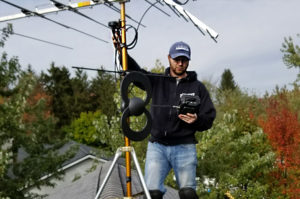Poor TV reception? Are you wondering why your TV signal goes in and out? Perhaps you are sitting down to watch TV after a long day. You turn on the TV and tune into your favorite show. Everything appears fine, and then all of a sudden, your picture starts to pixelate. Or perhaps a TV station you watched the night before now comes up as “No Signal.”

There are many reasons cord-cutters can experience poor TV reception from an antenna. Some of the reasons may be obvious, but other times it makes no sense at all. Let’s explore some of the typical TV reception problems and what to do about fixing the problem.
What causes poor TV reception?
Let’s start with the apparent and most common reason. You probably have the wrong antenna. Although many antenna companies claim to get in stations from 100+ miles, that’s pretty much a lie. Some manufacturers even claim their antennas work up to 400 miles. Could you imagine such an accomplishment? If this were true, you would get in every station in your home state, plus some states around you. To set the record straight, antennas cannot get in TV stations from over a hundred miles away.
At best, a long-range antenna atop a 48-foot tower can get in stations from about 65 miles or less. In contrast, an indoor TV antenna can usually get in TV stations from about 20 miles or less. And a good outdoor rooftop antenna can get stations in from about 50 miles or less. However, reliability is the crucial factor here. And no one likes to watch poor tv signal quality in the middle of their moment to relax. It kind of takes the relaxing part right away from the moment.
What else causes poor signal quality?
Besides the wrong antenna, here is a list of other factors that cause a TV signal to go in and out:
- Antenna direction
- Faulty antenna
- Poorly designed antenna
- Antenna misplacement
- Loose antennas
- Broken elements
- Bad antenna transformer
- Moisture anywhere in the system
- Distance from broadcast tower
- Bad connector
- Impairments in the coax
- Bad configuration
- DIY antenna installs
- LED lights
- Bad internal TV tuners
- Fluorescent lights
- Weather changes
- Atmosphere changes
- Wind
- Trees
- Planes, trains, and automobiles
- Adjacent buildings
- Microwaves
- Power tools
- Battery chargers
- Some GCFI Outlets
- Active computers
- Wireless devices
- Anything electrical
- Open connections
- Bad splitters
- Bad amplifier
- Wrong amplifier
- Wrong filter
- Overamplified
- Underamplified
- Unused rooms with no termination caps
- Nearby LTE cell towers
- Close FM towers
- Nearby ham radio operators
- Neighboring marine, police, fire, etc
- Adjacent factories
- Poor or no earth grounding
- Ground loops
- Power pole arcs
- Neighbors electronic devices
and the list goes on and on.
How do you fix TV pixelation?
Sometimes, you can’t fix TV reception issues. Some factors are out of your control. For example, you can’t change the distance of a broadcast tower unless you move closer. Also, you can not move a building that is next to you. Furthermore, if your neighbors are sending signals that interfere with your TV viewing, you are out of luck there too. However, there are some things you can do to improve your signal. We will look at a few of the things we can control.
First off, please never go on your roof or reconfigure wires unless you are trained or certified in doing so. Saving money is great, but how much do you save if you fall off your roof and can’t work anymore? When in doubt, call a professional. Transition TV serves all of West Michigan. You may contact us only if you live in the West Michigan area. Search our service area if in doubt. Anywhere else, and I recommend doing a google search for “antenna service near me.”
Antenna Placement and Direction
After choosing the correct antenna for your area, the most important factor is proper antenna placement and direction. Not unlike moving your cell phone around to get a better signal, TV antennas are the same. Likewise, driving in your car and listening to an FM station can sometimes go fuzzy, then back to perfect audio. So too, is a TV antenna.

As a professional antenna installer, I myself perhaps spend the most time fishing out the best rooftop spot for an antenna. This is important because once the antenna is mounted, it’s there to stay. So placing it correctly the first time is vital.
The secret’s out!
Most people would never know, but you can move an antenna over just a few feet and often times get a different result. The best way to explain this effect is to imagine TV signals as light and your antenna as a solar panel. In the same way, TV signals are defined as invisible forms of light known as radio waves. Yes, radio waves. Consequently, you would never place a solar panel in the shade. Likewise, you should never place an antenna in a dead spot. And TV signals/radio signals are very spotty as they pass through many trees and objects before they reach your home.
But how do you see TV signals when they are invisible? Ah, the very tricky part. A professional antenna installer will have a particular instrument. These spectrum analyzers, or signal meters, make the invisible TV signals appear on a screen. Unfortunately, it’s a guessing game of trial and error without one. A good one like Transition TV uses can cost thousands of dollars. However, there are cheap tv signal meters on Amazon. But don’t expect great things from any of them. Furthermore, one must understand how to use a signal meter properly. In addition, you must know the Radio Frequency channel of the TV station you are searching for.
Radio Frequency vs. Virtual Channel
Most TV stations operate on two channels. The first one is the actual Radio Frequency (RF). And the second one is the more familiar one known as the Virtual Channel. Since the digital transition of 2009, the FCC has been moving RF channels around. In the old days of analog fuzzy TV stations, one channel always meant one channel. Yes, you read that right.
In contrast, digital TV now allows broadcasters to send multiple channels over a single RF channel. For example, CBS Channel 3 of west Michigan used only to be found on 3. However, since the switch to digital TV, now it offers virtual channels 3-1, 3-2, and 3-3 but operates on RF channel 8. That’s three channels from the same tower. And all of the broadcasters do this today.
The real RF channels now range from VHF 2-13 and UHF 14-36. Meanwhile, virtual channels might show up on your TV 64 here in West Michigan. With airwaves becoming a high necessity with the explosion of cell phone use, the FCC has been rearranging the TV RF channels to cluster down to a shorter band of channels 2-36. Then they sell the other channels over to the cell phone companies for LTE services. Your cell phone now operates on some of the old TV stations—specifically, channels 58, 59, 60, and 61. And with 5g, now they fill 38, 39, 40, and 41 plus the upper voids once left allocated for them.
Conclusion
In conclusion, adjusting your antenna is going to be tricky. But it is the number one cause for poor TV reception. For the DIYer, I suggest the old-fashioned method of trial and error. Search Antenna Web for what TV stations are around you and what RF frequencies they broadcast on. Antenna Web can at least help you point your antenna in the proper direction. And if you are brave enough to try your luck with a signal meter, Antenna Web can help you know what RF channel to set your signal meter to.
Furthermore, make sure you have no impairments in your coax or connectors. If you stapled through your coax, bent it sharply, or see it deteriorating, then replace it. Your coax should never act like an antenna itself. If it does, then your actual antenna will not operate as it should. In addition, use F Type Terminators Caps on all unused connectors into unused rooms and splitters.
And last but not least, if you suddenly lose a station or get poor signal quality, start shutting off LED lights. Replacing LED lights is the easiest way to fix TV reception issues. If you find that an LED light is causing your station trouble, consider replacing it with a new one that mentions FCC compliance on the back of the box. Sometimes, better reception is just a light switch away.
